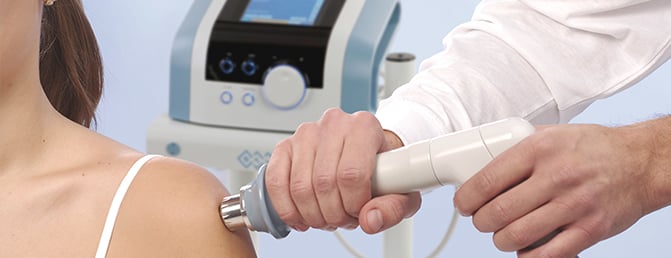
A Canadian clinic that doesn’t offer shockwave therapy may sound normal now, but I am convinced that including a shockwave therapy device in your treatment options will soon be considered an essential.
Every now and then, there is a new breakthrough technology that makes its way onto the market and quickly becomes indispensable to clinicians who want their practice to excel and truly want to help even the most chronic cases.
If you’ve never had the chance to try shockwave therapy before with your patients, you might be a little skeptical.
It’s perfectly normal to be.
I was skeptical myself when I was first introduced to shockwave therapy. I was convinced that between my manual skills, my acupuncture techniques and my ultrasound machine, I was able to effectively treat most of my patients’ conditions.
Well, as it turns out, there are some conditions that even my techniques aren’t effective enough to resolve. Calcifications in tendons are one of them. It’s nearly impossible to disperse or remove them with hands, needles or even ultrasounds.
A Last Resort Before Surgery
I have now been using shockwave therapy in my physiotherapy clinic for over four years. One of my first patients to try shockwave therapy was a close friend of mine – she let me “experiment” on her.
She had calcific tendinopathy on the left supraspinatus and had already gone through an intensive physiotherapy program. She eventually ended up seeking surgery. Her surgeon suggested that she try shockwave therapy as a last resort before considering surgery.
She reported no pain at rest. With movement, she would rate her pain level anywhere between 4 and 9 on a scale of 1 to 10. She was unable to reach above her head or behind her back without being in a significant amount of pain. You could see the pain register instantly just by reading her facial expression. Her functional levels were restricted to the use of her left arm at waist height: she couldn’t reach, carry, push or pull normally any longer.
Her 2011 ultrasounds results reported a calcium build-up of 2.8 cm by 1.7 cm on the left rotator cuff tendon.
Finally! A smile
On average, a patient would need 3 to 5 sessions of shockwave therapy to recover. In this patient’s case however, the first 5 sessions were incredibly painful. She reported a pain level of 8-9 on 10 during therapy. This abnormal pain level may be related to the larger amount of calcium buildup or it could simply be that her pain threshold was lower than average.
By the 6th session, however, the effects of the therapy finally started showing. She had now full active range of motion. It felt good to see her smile at last!
The amount of calcium built up in her shoulder was so great that we needed a total of 9 treatment sessions to remove it entirely.
After her 9th and final treatment, roughly 7 months later, she went back to see her surgeon. Based on the MRI findings, the surgeon was confident that surgery would not be necessary anymore.
The calcium deposit was gone. Her MRI scan reported zero calcifications on the same tendon!
This patient’s journey to recovery – one amongst many others – is why I believe every clinic should offer shockwave therapy.
But don’t just take my word for it.
Shockwave therapy is now more extensively used in the treatment of musculoskeletal injuries all around the world and is the subject of numerous studies that show its effectiveness and efficacy.
Interested, but still not convinced?
I’m hosting multiple workshops across Canada in 2017 on radial shockwave therapy and targeted radiofrequency therapy in which you will learn the physics principle behind these two modalities and the practical therapeutic applications and treatments on most common indications.
This workshop will be presented by myself and OrthoCanada’s Biomedical Engineer, Razi Khaddage, and all proceeds will be donated to the Physiotherapy Foundation of Canada.
To learn more about these workshops, visit the workshop section on our website!

If you are NOT a Healthcare Professional but have a question? Click here >
Free Shipping
On orders over $250
Learn More>
Get Expert Advice
For Healthcare Professionals only
1-800-561-0310
Contact us >
Technical Support
Does your equipment need
maintenance or calibration?
Contact us >
Finance Your Success
Leasing equipment is simple?
Learn more >
Customer Service Hours: Monday to Friday from 8:00 AM to 5:00 PM EST
Fax: 1-800-561-0349
Mailing Address: 170 Bombardier, Unit 1, Gatineau, QC J8R 0G5